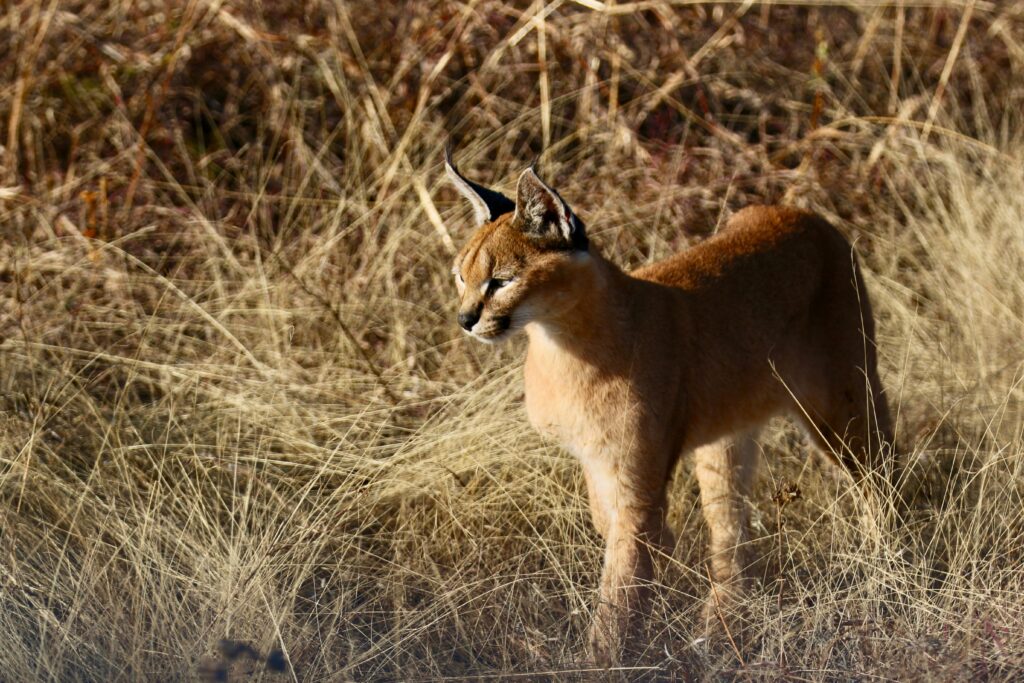The caracal (Caracal caracal) is a unique and fascinating wild cat species known for its agility, speed, and adaptability to harsh environments. Sometimes referred to as the “desert lynx,” this medium-sized feline is instantly recognizable by its tufted ears and sleek, powerful build. In this article, we’ll explore key facts about the caracal, delving into its habitat, diet, hunting skills, and reproduction while targeting the following keywords: caracal diet, caracal lifespan, caracal speed, caracal hunting abilities, caracal communication, and caracal predators.
1. Where Do Caracals Live? (Caracal Habitat)
The caracal’s natural habitat spans across several continents, including parts of Africa, the Middle East, Central Asia, and India. As an incredibly adaptable species, the caracal thrives in a variety of environments, from semi-deserts and scrublands to grasslands and woodlands. While they can survive in extreme climates like deserts, they are also found in areas with more vegetation, as long as there is sufficient prey to sustain them.
This flexibility in habitat is one reason for the caracal’s widespread presence compared to other wild cats. Where do caracals live? They are commonly found in areas with enough cover, such as bushes, tall grasses, or rocky terrain, where they can remain hidden and stalk prey. They do not need permanent water sources and can live in dry environments as long as prey is available.
2. What Do Caracals Eat? (Caracal Diet)
Caracals are carnivorous, and their diet is highly varied depending on what is available in their habitat. Their prey includes small mammals, birds, rodents, and reptiles, though they are also capable of taking down larger animals such as young antelope and gazelles. One of the most fascinating aspects of the caracal diet is their ability to hunt and catch birds, including those in mid-flight.
Caracals are opportunistic hunters and are known for their ability to leap high into the air—up to 3 meters (10 feet)—to catch birds. Their strong legs, sharp claws, and quick reflexes make them highly effective at pursuing prey. They usually hunt at night, relying on their excellent night vision and hearing to detect prey in the dark.
3. How Fast Can a Caracal Run? (Caracal Speed)
When it comes to speed and agility, caracals are among the top performers in the wild cat family. With their long, muscular legs and streamlined bodies, they can reach speeds of up to 80 km/h (50 mph). This remarkable caracal speed allows them to chase down swift prey and escape from potential threats.
Their impressive sprinting ability is coupled with a strong leap, making them efficient hunters. Whether they are chasing down small mammals or leaping into the air to snatch birds in flight, the caracal’s speed is crucial for survival.
4. How Do Caracals Hunt? (Caracal Hunting Abilities)
The caracal’s hunting abilities are a combination of stealth, speed, and power. They typically hunt alone, using a method called “stalk and pounce.” They quietly approach their prey, using their environment for cover, and then launch a rapid, forceful attack.
Caracals are also known for their exceptional leaping ability. In addition to running at high speeds, they can jump vertically to great heights, allowing them to capture flying birds. This unique technique sets them apart from many other wild cats, making the caracal one of the most skilled bird hunters.
They often prefer to ambush their prey near water sources or dense vegetation, where animals gather. Their acute sense of hearing, thanks to their large, tufted ears, helps them detect the slightest movement, making them one of the most efficient predators in their ecosystem.
5. Caracal Reproduction and Lifespan
Caracals reach sexual maturity at around 12 to 16 months of age. Breeding can occur throughout the year, but in some regions, it tends to be more seasonal. After a gestation period of about 68-81 days, females give birth to a litter of 1 to 6 kittens, though the average is usually 2 to 3.
Kittens are born with their eyes closed and are entirely dependent on their mother. They begin hunting with their mother at around 10 weeks of age and become independent between 9 to 10 months. The average caracal lifespan in the wild is around 10 to 12 years, though they can live longer in captivity, sometimes reaching up to 17 years.
6. How Do Caracals Communicate? (Caracal Communication)
Caracals are generally solitary and elusive animals, but they do communicate through a variety of vocalizations, scents, and body language. While they are not as vocal as some other wild cats, they can make several sounds, including growls, meows, hisses, and purrs. They also communicate through marking territory with scent glands located on their face, feet, and anal region.
Caracals use these markings to signal their presence to other caracals, especially during mating season. The tufts of hair on their ears, in addition to aiding hearing, may also serve a role in caracal communication, possibly to signal mood or intentions to other animals.
7. What Predators Do Caracals Face? (Caracal Predators)
Despite being top predators themselves, caracals do face threats from other larger carnivores in their environment. In Africa, caracal predators may include lions, leopards, hyenas, and African wild dogs. These larger predators can kill or outcompete caracals for prey. However, due to their elusive and agile nature, caracals often avoid confrontation by fleeing or hiding in dense cover.
Humans are also a significant threat to caracals, especially in areas where they come into conflict with farmers. Caracals sometimes prey on livestock such as sheep and goats, leading to retaliatory killings by farmers.
Conclusion
The caracal is a remarkable species that has adapted to survive in a wide range of environments. Its speed, agility, and hunting skills make it one of the most efficient predators in the animal kingdom. From its diverse diet to its powerful sprinting ability and impressive leaping skills, the caracal continues to fascinate both scientists and wildlife enthusiasts alike. While they face threats from larger predators and human activity, their elusive nature and adaptability offer hope for the continued survival of this iconic wild cat.
By understanding more about caracal habitat, diet, speed, and communication, we gain insight into their crucial role in maintaining balance within their ecosystems. Protecting this species from human conflict and habitat destruction is essential to ensuring that future generations can appreciate the beauty and agility of the caracal in the wild.



